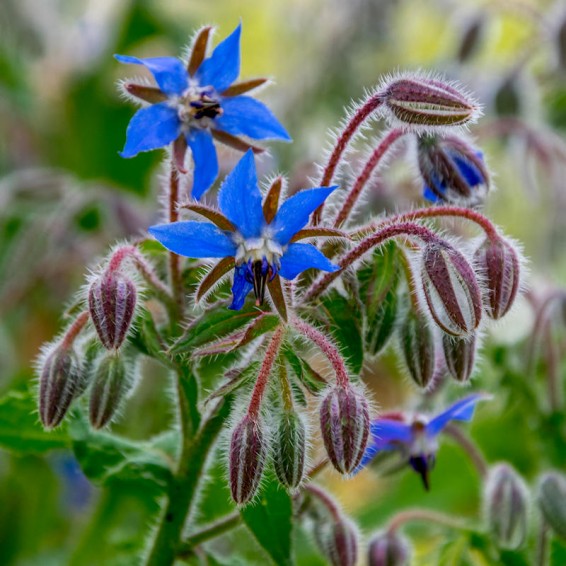Organic Borage Seeds
- HOW TO GROW
- FAST FACTS
- REVIEWS
HOW TO GROW
Sowing: Borage thrives in partial shade or full sun and well drained, rich soil; it can also grow very well in poor soil or dry conditions. Since it does not transplant well, direct seeding is the best option. After the last frost of spring when the soil has warmed, sow seeds 1/4" deep and 12-15" apart in rows 18" apart. Germination should occur within 7-14 days. As a companion plant to strawberries or tomatoes, borage improves pollination, discourages pests, and attracts bees.
Growing: Keep the soil fairly moist and weeds under control. Since too much soil contact can cause the drooping leaves to rot, a layer of mulch may be helpful. If the plant grows tall and begins to fall over, staking or a trellis may be necessary. Remove wilted blossoms to encourage new flowers.
Harvesting: About 6-8 weeks after planting when the plant has been well established, harvesting of the leaves can begin. Small, tender leaves are preferred for culinary use because the older leaves are covered with prickly hairs. Harvest the leaves or flowers in the morning after the dew has dried, choosing flowers that are just beginning to open. Though the leaves and flowers keep for several days in the refrigerator, they tend to lose their flavor when frozen.
Seed Saving: Borage reseeds itself very easily if left alone, though the seeds can easily be collected. Remove the seed heads when they have fully matured and begin to dry; spread them out in a protected location away from direct sunlight to finish drying. Thresh the seeds and remove the debris. Store the seeds in a cool, dry place.
FAST FACTS
Latin Name: Borago officials
Type: Open Pollinated, Heirloom, Cool Season|Warm Season
Life Cycle: Annual
USDA Zones: 3, 4, 5, 6, 7, 8, 9, 10, 11, 12
Seeds per Ounce: 1,250
Planting Method: Direct Sow
Sunlight: Full Sun
Height: 24 Inches
Color: Green, Blue
Bloom Season: Blooms Late Summer, Blooms Early Fall
Uses: Attracts Pollinators, Attracts Honeybees, Aromatic
Loving it!
100% Germ Rate! Cant wait to eat them and use the flowers in summer drinks. Beautiful Plants.
DESCRIPTION
HOW TO GROW
Sowing: Borage thrives in partial shade or full sun and well drained, rich soil; it can also grow very well in poor soil or dry conditions. Since it does not transplant well, direct seeding is the best option. After the last frost of spring when the soil has warmed, sow seeds 1/4" deep and 12-15" apart in rows 18" apart. Germination should occur within 7-14 days. As a companion plant to strawberries or tomatoes, borage improves pollination, discourages pests, and attracts bees.
Growing: Keep the soil fairly moist and weeds under control. Since too much soil contact can cause the drooping leaves to rot, a layer of mulch may be helpful. If the plant grows tall and begins to fall over, staking or a trellis may be necessary. Remove wilted blossoms to encourage new flowers.
Harvesting: About 6-8 weeks after planting when the plant has been well established, harvesting of the leaves can begin. Small, tender leaves are preferred for culinary use because the older leaves are covered with prickly hairs. Harvest the leaves or flowers in the morning after the dew has dried, choosing flowers that are just beginning to open. Though the leaves and flowers keep for several days in the refrigerator, they tend to lose their flavor when frozen.
Seed Saving: Borage reseeds itself very easily if left alone, though the seeds can easily be collected. Remove the seed heads when they have fully matured and begin to dry; spread them out in a protected location away from direct sunlight to finish drying. Thresh the seeds and remove the debris. Store the seeds in a cool, dry place.
FAST FACTS
Latin Name: Borago officials
Type: Open Pollinated, Heirloom, Cool Season|Warm Season
Life Cycle: Annual
USDA Zones: 3, 4, 5, 6, 7, 8, 9, 10, 11, 12
Seeds per Ounce: 1,250
Planting Method: Direct Sow
Sunlight: Full Sun
Height: 24 Inches
Color: Green, Blue
Bloom Season: Blooms Late Summer, Blooms Early Fall
Uses: Attracts Pollinators, Attracts Honeybees, Aromatic
Reviews
Review
Loving it!
100% Germ Rate! Cant wait to eat them and use the flowers in summer drinks. Beautiful Plants.






